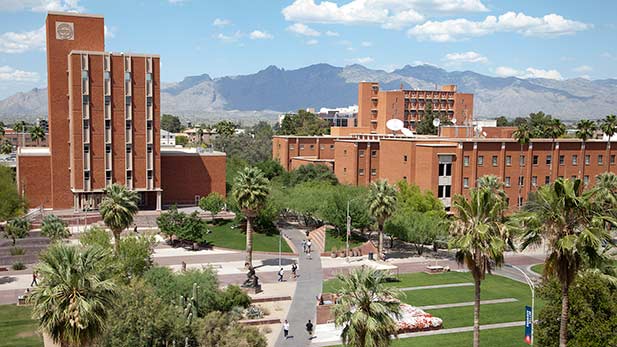 The Administration (left) and Modern Languages (right) buildings on the campus of the University of Arizona.
The Administration (left) and Modern Languages (right) buildings on the campus of the University of Arizona.Listen:
The University of Arizona eliminated 320 positions to meet $28.4 million in state funding cuts this fiscal year, the administration reported Thursday.
Across the university, 44 people were laid off, and another 64 positions were done away with via terminations, retirements and resignations.
"What I’d call, a normal part of our business," said Gregg Goldman, the university's chief financial officer. "Only 44 employees, unfortunately, no longer have jobs at the university not by their choice."
The budget cut report went to the Arizona Board of Regents meeting in Flagstaff Thursday.
Another 120 vacant positions were eliminated, and 96 jobs were downgraded from full time. The cuts were made in colleges and departments university-wide.
Goldman said the amount of work on campus remains the same, so with fewer faculty and staff, those who remain will shoulder heavier workloads.
"The university will try to offer the same level of service," he said. "But it’s going to be hard to do, and there will be impacts."
He said some of those include bigger classes, reduced course offerings and higher fees. He also noted that there will be an effect on the look and feel of campus.
Half of the eliminated jobs were staff positions; 90 were faculty and more than 60 were graduate assistant jobs.
"How these reductions flow through to which classes specifically are larger and what's the direct impact on students, we're not going know until we look backwards in a year or two," Goldman said.
Salaries, wages and benefits were the biggest areas cut, at $21.7 million, followed by $3.9 million in reduced travel, operations and capital spending. The university also imposed $2.8 million in increased overhead contributions on auxiliary units.
Examples of impacts listed by the university in its report:
-
The College of Social and Behavioral Sciences will experience "reduced offerings of classes in off-peak hours; reduced offerings for working students and professionals; reduced support for large class discussion sections."
-
Cuts to faculty numbers in the College of Agriculture "will lead to reduced research productivity."
-
In the College of Fine Arts, "salary inequities continue to not be addressed; visiting guest artist program (is) eliminated."
The state Legislature imposed about $100 million in cuts on the three public universities when it passed the budget in March, about $25 million more than Gov. Doug Ducey had proposed. Ducey went along with the cuts, which were made proportionally based on enrollment.
Members of the Board of Regents decried the cuts at the time, and the board passed a resolution asking for restoration of cut money when the state's budget picture improved.
This fiscal year's higher education cuts brought to more than $500 million cut in state funding over the last several years.



By submitting your comments, you hereby give AZPM the right to post your comments and potentially use them in any other form of media operated by this institution.